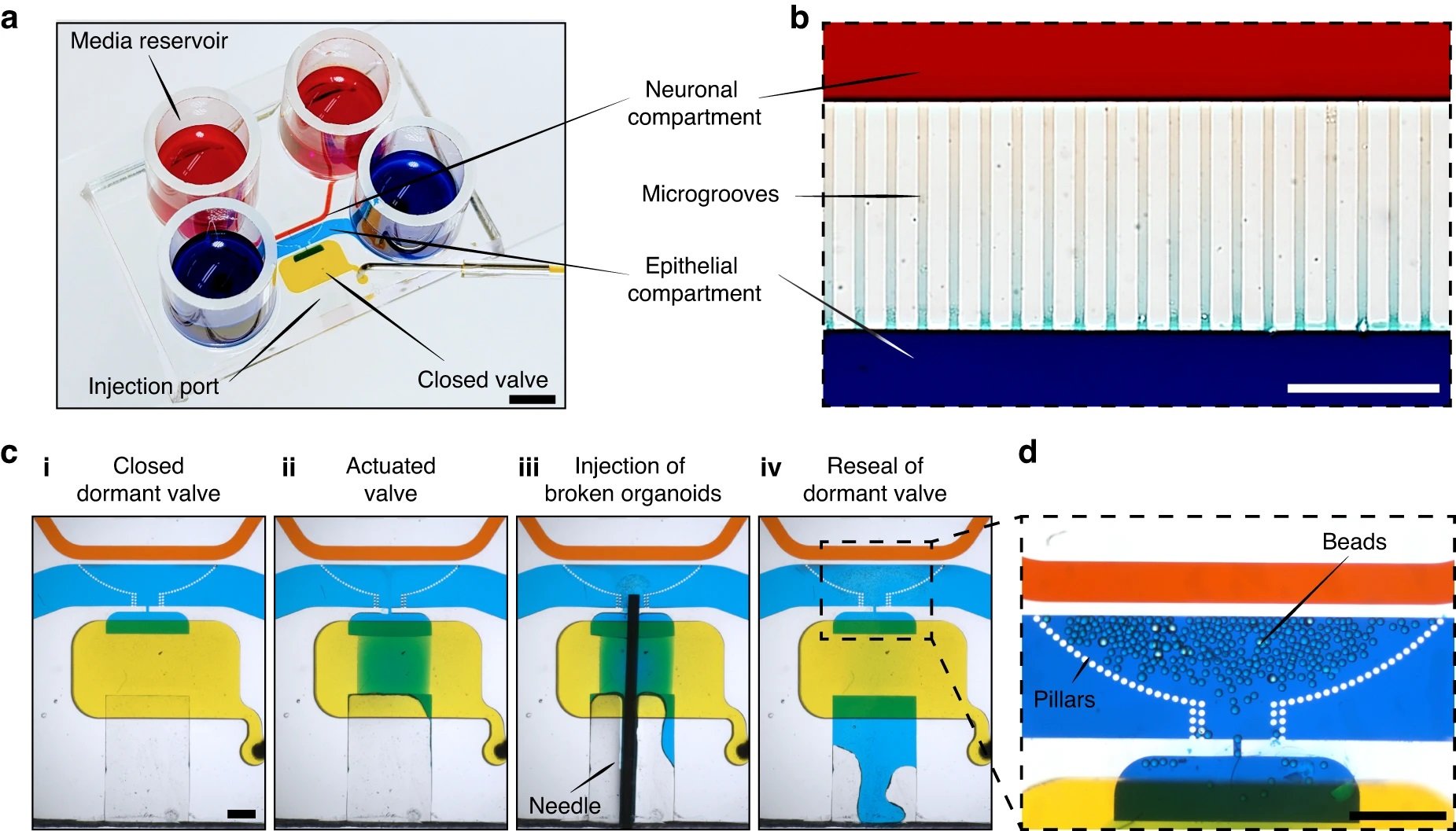
23 Nov Exploring Gut-Brain Interactions with a Co-Culture Microfluidic Device
The human gut is a complex ecosystem, filled with a myriad of chemical and physical stimuli. Intestinal epithelial cells, which line the gut, play a crucial role in sensing these stimuli and communicating with enteric neurons. These neurons are integral to coordinating various physiological processes essential for normal digestive function. However, understanding the intricate neuroepithelial connections within the gut has been challenging due to the lack of tools that can effectively orchestrate interactions between these cellular compartments. In a recent study, a team of researchers has developed a two-compartment microfluidic chip specifically designed for co-culturing enteric neurons with intestinal epithelial cells. This device features epithelial and neuronal compartments connected by microgrooves, allowing for direct interaction between these two cell types.
“We describe the development of a two-compartment microfluidic device for co-culturing enteric neurons with intestinal epithelial cells. The device contains epithelial and neuronal compartments connected by microgrooves. The epithelial compartment was designed for cell seeding via injection and confinement of intestinal epithelial cells derived from human intestinal organoids. We demonstrated that organoids planarized effectively and retained epithelial phenotype for over a week.“, the authors explained.

“a Intestinal epithelial cells are located on the luminal lining of the gut. Upon receiving physical or chemical stimuli, intestinal epithelial cells communicate with enteric neurons such as IPANs in the myenteric plexus which is located between the circular and longitudinal layers of muscularis externa of the gut. Neuro-epithelial communications trigger expansion or contraction of the muscle layers in the gut. b Our microfluidic culture system was designed to recapitulate aspects of the neuro-epithelial interactions observed in vivo. This culture platform allowed to define and visualize neuro-epithelial contacts” Reproduced from de Hoyos-Vega, J.M., Yu, X., Gonzalez-Suarez, A.M. et al. Modeling gut neuro-epithelial connections in a novel microfluidic device. Microsyst Nanoeng 9, 144 (2023). under Creative Commons Attribution 4.0 International License.
The epithelial compartment of the device is engineered for cell seeding via injection, ensuring the confinement of intestinal epithelial cells derived from human intestinal organoids. The researchers demonstrated that these organoids effectively planarize and retain their epithelial phenotype for over a week within the device.
In the neuronal chamber, intestinal myenteric neurons, including intrinsic primary afferent neurons (IPANs), were cultured. These neurons, derived from transgenic mice expressing the fluorescent protein tdTomato, extended projections into the microgrooves, making frequent contacts with the epithelial cells. Notably, the presence of epithelial cells in the adjacent compartment enhanced the density and directionality of these neuronal projections.
This novel microfluidic device represents a significant leap forward in the study of gut neuroepithelial connections. It provides a platform that could be used to dissect the structure and function of these connections in various organs, including the skin, lung, and bladder, both in health and disease. The insights gained from this research could pave the way for a deeper understanding of the gut-brain axis and its role in various gastrointestinal disorders and diseases.

“a An image of the microfluidic device. Neuronal and epithelial sides of the microfluidic device were filled with red and blue dye respectively. Yellow dye shows the normally closed valve. Cloning cylinders were used as media reservoirs. Scale bar: 5 mm. b Close-up view of the microgroove region located at the junction of neuronal and epithelial compartments. Scale bar: 100 µm. c A series of images describing the steps of valve opening, needle insertion, transfer of organoid pieces and re-sealing of the valve. d A close-up view showing that an array of posts helped retain polystyrene microbeads (100 μM diameter, approximating the size of organoid fragments) at the interface with neuronal compartment. Scale bar: 1 mm” Reproduced from de Hoyos-Vega, J.M., Yu, X., Gonzalez-Suarez, A.M. et al. Modeling gut neuro-epithelial connections in a novel microfluidic device. Microsyst Nanoeng 9, 144 (2023). under Creative Commons Attribution 4.0 International License.
The development of this microfluidic device marks a crucial step in biomedical engineering and medical research. It opens new avenues for exploring the complex interactions between the gut and the brain, enhancing our understanding of the human body’s internal communication systems.
“We should note that our paper focuses on establishing a methodology to co-culture intestinal epithelial cells with enteric neurons and stops short of assessing the structure and function of contacts formed in these co-cultures. This assessment represents the next phase of our work. Overall, the microfluidic device described may, in the future, be used to improve understanding of disease mechanisms that underly functional gastrointestinal disorders, such as irritable bowel syndrome (IBS).“, the authors concluded.
For more insights into the world of microfluidics and its burgeoning applications in biomedical research, stay tuned to our blog and explore the limitless possibilities that this technology unfolds.
Figures are reproduced from de Hoyos-Vega, J.M., Yu, X., Gonzalez-Suarez, A.M. et al. Modeling gut neuro-epithelial connections in a novel microfluidic device. Microsyst Nanoeng 9, 144 (2023). https://doi.org/10.1038/s41378-023-00615-y under a Creative Commons Attribution 4.0 International License)
Read the original article: Modeling gut neuro-epithelial connections in a novel microfluidic device


